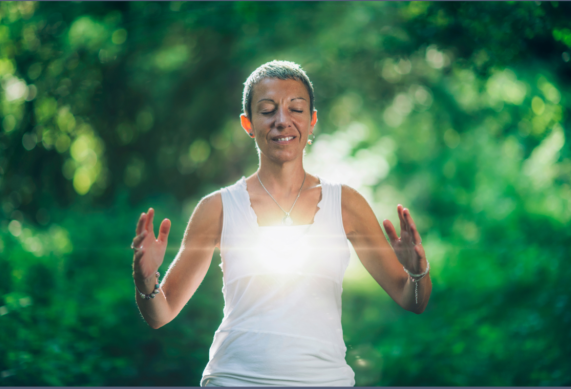Mindfulness Meaning

Mindfulness involves the practice of being completely present and immersed in the current moment, free from judgment or distraction. It encompasses the act of attentively observing one’s thoughts, emotions, physical sensations, and the environment with an attitude of openness and curiosity. Mindfulness practise comes in various forms and in this blog, we’ll walk you through the top 10.
Are Mindfulness and Meditation the Same Thing

Mindfulness and meditation are related concepts but not exactly the same.
Mindfulness is the practice of paying attention to the present moment without judgment. It involves being fully aware of your thoughts, feelings, bodily sensations, and the surrounding environment. Mindfulness can be practiced formally through meditation exercises, but it can also be integrated into everyday activities like eating, walking, or washing dishes.
Meditation, on the other hand, is a specific technique or practice that aims to cultivate mindfulness, concentration, and relaxation. Meditation often involves sitting quietly and focusing the mind on a specific object, such as the breath, a mantra, or a visualization. While mindfulness meditation is a common form of meditation, there are many different types of meditation practices, each with its own focus and approach.
In summary, mindfulness is a broader concept that encompasses a state of awareness and presence in the moment, while meditation is a specific practice or technique used to cultivate mindfulness and other mental qualities.
How Does Mindfulness Help

Mindfulness boosts energy in several ways:
a) Reducing Stress: Mindfulness helps to calm the mind and body, reducing the production of stress hormones like cortisol. By lowering stress levels, mindfulness prevents the draining effects of chronic stress on energy levels.
b) Increasing Focus: By training the mind to stay present, mindfulness enhances concentration and cognitive function. This improved focus allows individuals to direct their energy more efficiently towards tasks and activities, leading to increased productivity and vitality.
c) Enhancing Sleep Quality: Mindfulness practices, such as meditation and deep breathing, promote relaxation and help to quiet the mind before bedtime. Better sleep quality translates to higher energy levels and improved overall well-being.
d) Cultivating Awareness: Mindfulness heightens awareness of bodily sensations and emotions, allowing individuals to recognize signs of fatigue or burnout early on. By tuning into these signals, individuals can take proactive steps to rest and recharge before energy levels plummet.
e) Promoting Emotional Resilience: Mindfulness equips individuals with the tools to navigate challenging emotions and situations with greater ease. By fostering emotional resilience, mindfulness prevents energy-draining cycles of worry, rumination, and negativity.
Overall, mindfulness boosts energy by reducing stress, enhancing focus, improving sleep quality, cultivating awareness, and promoting emotional resilience. By incorporating mindfulness practices into daily life, individuals can experience sustained energy and vitality to tackle life’s challenges with ease.
Top 10 Mindfulness Practises For 60+ Energy Boost
Feeling a dip in energy and vitality? As we get older, it’s crucial to keep our energy levels high for our overall health. Mindfulness practices can be a key part of your daily routine to enhance your energy and refresh your spirit. This blog will delve into the top 10 mindfulness exercises specifically designed for those over 60, their impact on boosting energy, the risks of overlooking these practices, the significance of regularity, and when you might start noticing their positive effects.
Mindfulness: Deep Breathing

Step 1: Find a comfortable seated position or lie down on your back.
Step 2: Close your eyes and relax your body.
Step 3: Place one hand on your chest and the other on your abdomen.
Step 4: Inhale deeply through your nose, feeling your abdomen rise as you fill your lungs with air.
Step 5: Exhale slowly through your mouth, feeling your abdomen fall as you release the air.
Step 6: Focus on the sensation of your breath as it moves in and out of your body.
Step 7: Repeat this deep breathing pattern for several minutes, allowing each breath to bring a sense of calm and relaxation.
Step 8: Notice how deep breathing soothes your mind, reduces stress, and increases your energy levels, leaving you feeling refreshed and rejuvenated.
Mindfulness Meditation Practice:

Step 1: Find a quiet and comfortable space to sit or lie down.
Step 2: Close your eyes and take a few deep breaths to center yourself.
Step 3: Bring your attention to the present moment by focusing on your breath. Notice the sensation of the air entering and leaving your body.
Step 4: As thoughts arise, gently acknowledge them without judgment and then return your focus to your breath.
Step 5: Continue to breathe mindfully, allowing yourself to fully immerse in the present experience.
Step 6: With each breath, feel a sense of calmness and clarity washing over you, helping to still your mind and relax your body.
Step 7: Practice this mindfulness meditation for a few minutes each day, gradually increasing the duration as you become more comfortable.
Step 8: Notice how regular meditation sessions enhance your mental sharpness, alleviate tiredness, and boost your energy levels, allowing you to approach each day with greater clarity and vitality.
Yoga:

Yoga combines gentle movements with mindful breathing, promoting flexibility, strength, and relaxation. Even just a few minutes of yoga each day can revitalize your body and mind.
Tai Chi

Tai Chi is a gentle, flowing martial art that focuses on mindfulness and balance. Engaging in Tai Chi practice can improve the flow of energy within the body, resulting in a sense of rejuvenation and vitality.
Nature Walk Mindfulness Practice:

Step 1: Find a tranquil outdoor location, such as a park, forest, or beach. Step 2: Begin by standing still and taking a few deep breaths, feeling the air fill your lungs and noticing the sensations in your body. Step 3: As you start walking, focus your attention on the sights, sounds, and smells of nature around you. Notice the colors of the leaves, the rustling of the wind through the trees, and the scent of flowers in the air. Step 4: Pay attention to each step you take, feeling the ground beneath your feet and the muscles in your legs as they move. Step 5: If your mind starts to wander, gently bring your focus back to the present moment by reconnecting with your breath and the sensations of walking. Step 6: Take your time and allow yourself to fully experience the beauty and tranquility of nature as you continue your walk. Step 7: Before you finish, take a moment to express gratitude for the natural world around you and the opportunity to connect with it. Step 8: Carry the sense of peace and rejuvenation with you as you return to your daily activities.
Gratitude Mindfulness Practice:

Step 1: Set aside a quiet moment in your day to sit comfortably and relax.
Step 2: Close your eyes and take a few deep breaths, allowing yourself to settle into the present moment.
Step 3: Bring to mind three things you’re grateful for today. They can be big or small, simple or significant.
Step 4: As you reflect on each one, notice how it makes you feel. Let yourself fully experience the gratitude and appreciation in your heart.
Step 5: Take another deep breath and send a silent thank you to yourself for taking the time to cultivate gratitude.
Step 6: When you’re ready, gently open your eyes and carry this sense of gratitude with you as you continue your day.
Step 7: Repeat this practice daily to nurture a mindset of gratitude and positivity in your life.
Mindful Eating Practice:

Step 1: Before you begin eating, take a moment to pause and breathe deeply, bringing your awareness to the present moment.
Step 2: As you take your first bite, notice the colors, textures, and smells of your food. Engage your senses fully.
Step 3: Chew each bite slowly and deliberately, savoring the flavors and sensations in your mouth.
Step 4: Pay attention to how your body feels as you eat. Notice any signals of hunger or fullness.
Step 5: Try to eat without distractions, such as TV or phones, so you can fully focus on the experience of eating.
Step 6: Express gratitude for the food you’re eating and the nourishment it provides to your body.
Step 7: After you finish eating, take a moment to reflect on how you feel. Notice any changes in your energy levels or mood.
Step 8: Practice this mindful eating exercise regularly to cultivate a deeper connection with your food and promote overall well-being.
Digital Detox Mindfulness Practice:

Step 1: Set aside dedicated times throughout the day to disconnect from electronic devices, such as phones, computers, and tablets.
Step 2: During these breaks, engage in activities that don’t involve screens, such as reading a book, going for a walk, or spending time in nature.
Step 3: Use this time to focus on being present in the moment and connecting with your surroundings.
Step 4: Notice how you feel when you’re away from screens. Pay attention to any changes in your energy levels or mental clarity.
Step 5: Be mindful of your screen usage throughout the day, and try to limit unnecessary screen time.
Step 6: Experiment with different tech-free activities to find what brings you joy and relaxation.
Step 7: Embrace the benefits of digital detoxing, including improved focus, reduced stress, and increased energy levels.
Step 8: Make digital detoxing a regular part of your routine to support your overall well-being and vitality.
Creative Expression Mindfulness Practice:

Step 1: Set aside time each day to engage in a creative activity that you enjoy, whether it’s painting, writing, or playing music.
Step 2: Create a comfortable and inspiring space where you can fully immerse yourself in the creative process.
Step 3: Allow yourself to let go of any self-judgment or expectations and simply focus on the act of creation.
Step 4: Notice how you feel as you engage in your chosen creative activity. Pay attention to any feelings of joy, inspiration, or relaxation that arise.
Step 5: Embrace the process of creative expression as a form of self-care and nourishment for your mind, body, and soul.
Step 6: Experiment with different creative mediums and techniques to discover what resonates with you the most.
Step 7: Be open to exploration and playfulness in your creative endeavours, allowing yourself to express your unique voice and perspective.
Step 8: Celebrate your creative achievements and recognize the value of nurturing your creativity as a means of boosting your overall energy and vitality.
Social Connection Mindfulness Practice:

Step 1: Set aside time each week to connect with friends and loved ones, either in person or virtually.
Step 2: Choose activities that foster meaningful connections, such as sharing a meal, going for a walk together, or engaging in a hobby you both enjoy.
Step 3: Practice active listening and genuine engagement during your social interactions, allowing yourself to fully connect with the people around you.
Step 4: Notice how you feel during and after spending time with others. Pay attention to any feelings of joy, comfort, or rejuvenation that arise.
Step 5: Prioritize quality over quantity in your social connections, focusing on nurturing relationships that bring positivity and fulfillment into your life.
Step 6: Be open to new social opportunities and experiences, allowing yourself to expand your social circle and deepen existing connections.
Step 7: Express gratitude for the relationships in your life and the positive impact they have on your energy and vitality.
Step 8: Make social connection a regular part of your routine, recognizing its importance in supporting your overall well-being and boosting your energy levels.
Consistency is key when it comes to reaping the benefits of mindfulness practices. Aim to incorporate at least 10-15 minutes of mindfulness into your daily routine, gradually increasing the duration as you become more comfortable. Over time, you’ll notice improvements in your energy levels, mood, and overall well-being.
So, start today and unleash your inner vitality with these mindfulness practices tailored for individuals over 60!
